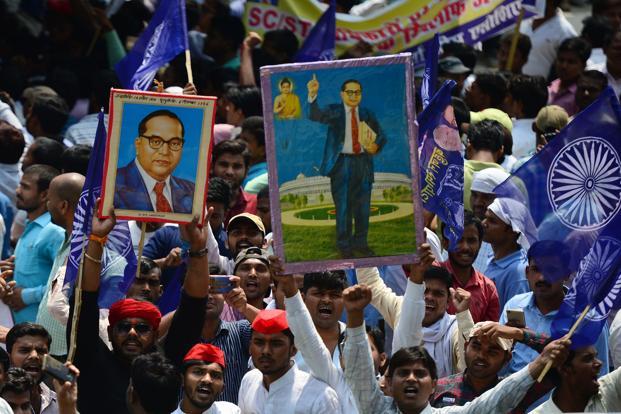The brutal events of the Kathua case are still haunting us. In my last blog I have described the need to call for a change of the old ways! We need to ask questions, we need to challenge male dominated hierarchies and male privilege. This way we can achieve social change because we aren’t afraid of asking and challenge inviolable social hierarchies.
It is the violence in the current social order that is alarming! Especially minorities and dominated, marginalized groups of society suffer from an atmosphere of fear that is created by certain (political) groups. Analyzing the power relations between the dominated and subordinated masculinities, as it is my overall objective, I would argue that caste is the overarching form of discrimination that connects all masculinities, to some extent also from non-Hindu communities, because it is the basic structure of the social order in India.


Over the last weeks of my research on masculinity in India, I repeatedly came across caste. I would like to share with you of my observations and conversations in this blog, for example, from my recent trip to Vasant Vihar’s Kusumpur Pahari. I had the chance to chat with two male Dalit activists about their situation and their experiences of belonging to the Dalit community. Thankfully, these two were happy to answer my questions and I am very grateful for that.


They talked about the intimidating situation for Dalits in the villages of Uttar Pradesh, where many families in the area are originally from. Many of them had to fled to Delhi to escape the oppression by upper-caste families and the tight grip of the caste system. They wanted to provide an education for their children and a better livelihood. In their village, so they told me, five upper caste families are dominating and ruling the whole village by limiting access to public spaces or using structural and actual violence to put people into “their” place. The grip of the upper-caste over Dalits shall impose a strict regime which lays down a set of rules that everyone has to follow and that is enforced with violence if necessary. I have experienced it myself in Uttarakhand’s Kumaon Division that the caste system is well in place with distinct living quarters and separate khet for each caste, no mixing allowed.
Even if the situation for Dalits is better in big cities, like here in Delhi, people are still facing discrimination, mainly on the governing bodies of the ward and other municipal institutions as my interlocutors confided in me. In urban areas, so it seems, the structural discrimination of Dalits is the distinctive form, physical violence is less common. But the structural discrimination is as appalling and it severely effects marginalize and vulnerable groups of society, for example, when informal settlements are torn down and demolished which mostly house SC/ST persons. The government’s goal to create clean and safe modern global city sounds desirable but it means that many people from the lower social and economic spheres are loosing their livelihood. Additionally, Dalit men and Hawkers on the streets are constructed by the majority as a safety risk, especially for women, hence “cleaning the city” means also to get rid of subordinated masculinities, as Shilpa Phadke and her co-authors have found out in their very important book “Why Loiter? Women and Risk on Mumbai Streets” (2011). Perhaps this takes us too far away, but it demonstrates who is welcomed in the city by policy makers (I’d guess mostly male), who has the right to live in the city and who is seen as a safety risk or a hindrance on the mission to “clean” the cities. It shows us the inherent structural discrimination of SC/ST groups of society.
Ambedkar’s aim, integrated into the Indian constitution, had been the uplifting of Dalits from the bottom of social hierarchies to accomplish the promises of a caste-mukht society. However, we can see what is happening in India when Dalits claim their citizen’s rights! They get harassed, harmed and even killed, Dalit women get raped. The persecution of the perpetrator is slow or non existent. My chat partner in Kusumpur Pahari put great emphasis on the fact that there’s no justice for Dalit women who have been raped in India. Is this perhaps the punishment from people in power for challenging the imposed social order by participating in the public life?
My recent experiences with so-called Brahmin activists or Hindutva nationalist on Twitter made me wonder: Why are these activists – aapka hardik swagat, if you guys have actually read until here! – why are you feeling so scared and attacked? Why do you feel more entitled to claim a power position within society and why do you try to limit others men’s access to the public or to different profession fields? Why do you subsequently deny equality and human rights for Dalits even though it is their entitled right as citizens of India? Perhaps, because Hindu nationalist don’t regard Dalits as Indians. If anyone of you would like to answer it, dear Hindutva activists, kindly share your view with me to help me understand why Dalits are second class citizens for you?
Lastly, please let me conclude with a couple of observations regarding caste that have left me thinking. In some way these correspond with Ashwini Deshpande’s thoughts in her article published in The Wire about the claim of India’s elite of being caste-mukht but actually showing an inherent discrimination towards Dalits. Please do let me share two examples that illustrate the lack of awareness and knowledge about the inherent structural discrimination by some influencers and activists: at an event, organized at a bar in Aurobindo Market about Gender empowerment and social media, a young actress replied to a question about Dalits in Bollywood that, firstly, we have to liberate women and achieve equality for them and then, maybe, we can manage to achieve the same for Dalit people as well; or the two comediennes at another event claimed that everyone can achieve success in comedy indifferent of caste… well, easy to say when you are upper-caste. For them, the starting point is much higher as for comedians from the Dalit community, I would argue. We need to stop the structural discrimination of Dalits as much as we need the liberation of women. It’s not one against the other.
We need to understand that we have to fight together in solidarity with the marginalized for social change! The old hierarchies and the patriarchal social order ae not only limiting women’s rights, the hegemonic masculinities are also subordinating other masculinities to keep the current social order in place. We want to stand against patriarchy? So we need to stand against caste discrimination as well. We need equality and justice and a livelihood for all. Join us! Tweet, post, protest with us and change society!
About the Author


Erik is a graduate student from Berlin, and has engaged in research on masculinity, gender and the urban. He is currently living in Delhi and calls himself a Bombaywala at heart.




